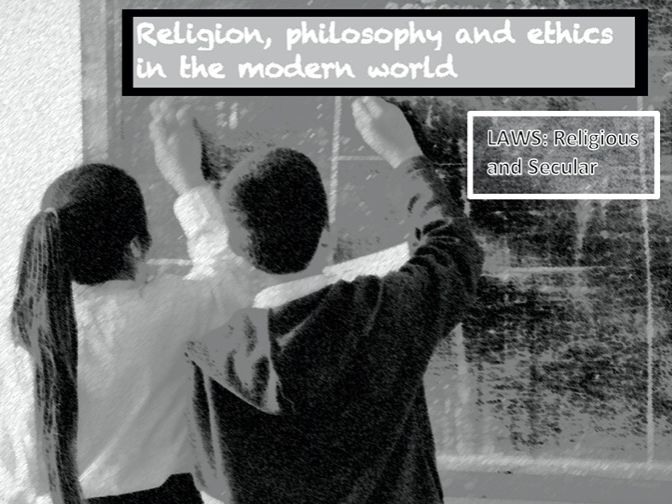59Uploads
13k+Views
2k+Downloads
Religious education
Sale

Understanding Religious and Secular Laws
This is a 30 slide colour PowerPoint Presentation, with animated slides and interactive questions. The last several slides are designed for exam preparation for OCR General Certificate of Secondary Education.
It is also useful for discussing broader questions, such as the differences between morality and law, or secularism and theocracy.
Learning Outcomes:
Understand the difference between secular and religious laws.
For United Kingdom GCSE Religious Studies (9–1)
Unit J625/06: Religion, philosophy and ethics in the modern world from a Christian perspective
Unit J625/07: Religion, philosophy and ethics in the modern world from a Muslim perspective
Bundle Sale

Religious Studies Bundle
This bundle contains three colorful, interactive PowerPoint Presentations that can be used for full lessons on religious beliefs about a variety of topics, including: human rights, social justice, law, secularism, crime and punishment.
It references both Christianity and Islam and can be used to broaden discussion to more philosophical questions such as:
What is the relationship bewteen religious concepts of justice and society’s laws?
Which is the best reason / purpose for punishment?
Why do liberals believe that morality is a private matter?
Sale

Religious Versus Secular Laws
This 38 full color **interactive **slide presentation can be used to teach many concepts pertaining to religion and society. It explains the relationship between modern states (primarily the United States and Great Britain) and religions (with focus on Christianity & Islam). Concepts such as secularism, liberalism, theocracy and apostasy are included. Religious teachings are used and analysed, so that students are taught to demonstrate knowledge of **religious approaches to law **as well as applications and analysis. Exam practice questions are provided as well as guidance on how to answer them.
This is also useful for citizenship and cultural studies courses.
Sale

Religious Attitudes to Sex: Christianity & Islam
This full colour 13-slide PowerPoint presentation covers the principle beliefs about sex and its proper context in both the Christian and Islamic faiths.
It provides a good overview for this topic for the GCSE in Religious Studies and works well as a lesson plan if coupled with a revision quiz or practice test question. THe resource ends with two questions that could be used as discussion prompts or retention checks.
Sale

RELIGION, HUMAN RIGHTS & SOCIAL JUSTICE
Ideal for teaching and revising the
AQA Religious Studies A, Component 2 – thematic studies
Theme F: Religion, human rights and social justice (GCSE).
This 56-slide PowerPoint presentation covers the AQA curriculm and textbook’s main definitions and helps
GCSE students prepare a good set of answers for the exams.
It will encourage critical thinking about the examination board’s definitions and assumptions at certain points, but will not prevent students from saying the “right” answers needed to pass the examination.
Sale

Christianity, Crime and Punishment
This 23 slide full colour animated PowerPoint Presentation introduces students to the **Christian outlook on crime & punishment (including the concepts of retribution, deterrence and rehabilitation).
It offers an open and questioning approach that allows students to weigh different outlooks and consider the concept of ‘crime’ and the reasons for punishment.
It prompts discussion and can be used to stimulate reflection.
Sale

Religious Studies: Marriage & the Family
This 30 slide full-colour interactive powerpoint presentation informs students about religious beliefs about marriage and the family. Topics covered include the Muslim and Christian marriage ceremony as well as Civil Partnerships, definitions of marriage, arranged marriages, reasons for marriage, roles in marriage, vows, the nature of families, cohabitation and same-sex marriage.
The resource helps students to prepare for the GCSE Exams in Religious Studies as well as helping students of religious faith to understand the rite of marraige and how religions and non-religious people view it.
The resource offers lots of discussion prompts to encourage class discussion.
This resource could be used as a two-hour lesson.







